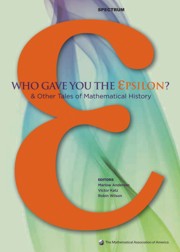Book contents
- Frontmatter
- Introduction
- Contents
- Analysis
- Foreword
- Who Gave You the Epsilon? Cauchy and the Origins of Rigorous Calculus
- Evolution of the Function Concept: A Brief Survey
- S. Kovalevsky: A Mathematical Lesson
- Highlights in the History of Spectral Theory
- Alan Turing and the Central Limit Theorem
- Why did George Green Write his Essay of 1828 on Electricity and Magnetism?
- Connectivity and Smoke-Rings: Green's Second Identity in its First Fifty Years
- The History of Stokes' Theorem
- The Mathematical Collaboration of M. L. Cartwright and J. E. Littlewood
- Dr. David Harold Blackwell, African American Pioneer
- Afterword
- Geometry, Topology and Foundations
- Algebra and Number Theory
- Surveys
- Index
- About the Editors
Alan Turing and the Central Limit Theorem
from Analysis
- Frontmatter
- Introduction
- Contents
- Analysis
- Foreword
- Who Gave You the Epsilon? Cauchy and the Origins of Rigorous Calculus
- Evolution of the Function Concept: A Brief Survey
- S. Kovalevsky: A Mathematical Lesson
- Highlights in the History of Spectral Theory
- Alan Turing and the Central Limit Theorem
- Why did George Green Write his Essay of 1828 on Electricity and Magnetism?
- Connectivity and Smoke-Rings: Green's Second Identity in its First Fifty Years
- The History of Stokes' Theorem
- The Mathematical Collaboration of M. L. Cartwright and J. E. Littlewood
- Dr. David Harold Blackwell, African American Pioneer
- Afterword
- Geometry, Topology and Foundations
- Algebra and Number Theory
- Surveys
- Index
- About the Editors
Summary
Because the English mathematician Alan Mathison Turing (1912–1954) is remembered today primarily for his work in mathematical logic (Turing machines and the “Entscheidungsproblem”), machine computation, and artificial intelligence (the “Turing test”), his name is not usually thought of in connection with either probability or statistics. One of the basic tools in both of these subjects is the use of the normal or Gaussian distribution as an approximation, one basic result being the Lindeberg-Feller central limit theorem taught in first-year graduate courses in mathematical probability. No-one associates Turing with the central limit theorem, but in 1934 Turing, while still an undergraduate, rediscovered a version of Lindeberg's 1922 theorem and much of the Feller-Lévy converse to it (then unpublished). This paper discusses Turing's connection with the central limit theorem and its surprising aftermath: his use of statistical methods during World War II to break key German military codes.
1 Introduction
Turing went up to Cambridge as an undergraduate in the Fall Term of 1931, having gained a scholarship to King's College. (Ironically, King's was his second choice; he had failed to gain a scholarship to Trinity.) Two years later, during the course of his studies, Turing attended a series of lectures on the Methodology of Science, given in the autumn of 1933 by the distinguished astrophysicist Sir Arthur Stanley Eddington. One topic Eddington discussed was the tendency of experimental measurements subject to errors of observation to often have an approximately normal or Gaussian distribution.
- Type
- Chapter
- Information
- Who Gave You the Epsilon?And Other Tales of Mathematical History, pp. 52 - 60Publisher: Mathematical Association of AmericaPrint publication year: 2009



